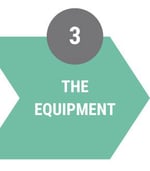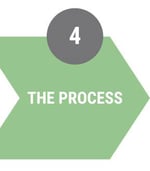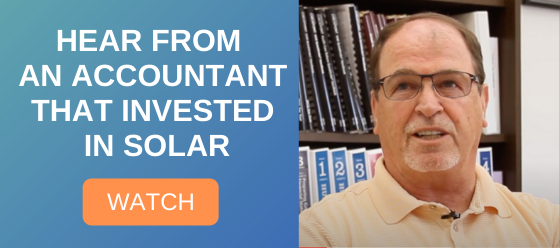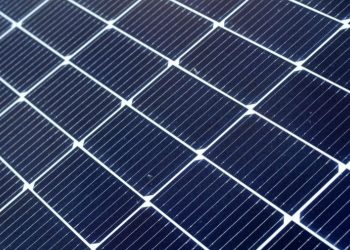If you’re a business leader who’s ready to control a fixed cost, pay fewer taxes, and be on your way to saving more of your hard-earned money, then you’ve come to the right place. That’s exactly what you can accomplish by investing in commercial solar panels.
But solar isn’t for everyone, and the process of investigating solar for your business can be daunting. That’s why we created this commercial solar panel investment guide. In it, you will find answers to many of the questions that will help you determine if solar is right for your business and if it is, help you be on your way to a successful solar investment.
Whether your business is a one-person show or a large corporation, this guide is for you.
The Basics of Commercial Solar
How Does A Commercial Solar Panel System Work?
A commercial solar energy system consists of solar panels strategically installed on the rooftop or grounds of your commercial property. The solar panels comprise of photovoltaic (PV) cells, which convert sunlight into direct current (DC) electricity. The generated electricity flows through the solar inverter, which converts DC into alternating current (AC) electricity needed to power your business.
Electricity flows from the inverters to a distribution panel, which allocates it to power your facility. If your system produces more than your facility needs, it will be sent to the utility grid, and you’ll be compensated through net metering. Your electric meter will track the electricity flowing to and from the utility grid.
Read more: How a grid-tied commercial solar panel system works
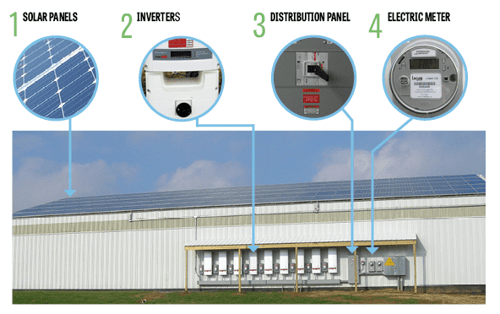
What are the Different Types of Commercial Solar Installations?
There are three main types of commercial installations. The most common installation type is a roof mount. Ground mounts and carports are also popular installation types for businesses.
Roof mounts can be installed on many types of roofs, including shingle, corrugated metal, standing-seam metal, and flat rubber roofs where a weighted ballast mount is used. Special attachments are designed for attaching panels to metal roofs.
Ground mounts and carports are great options for businesses that don’t have adequate roof space or simply don’t want solar panels on their roof.
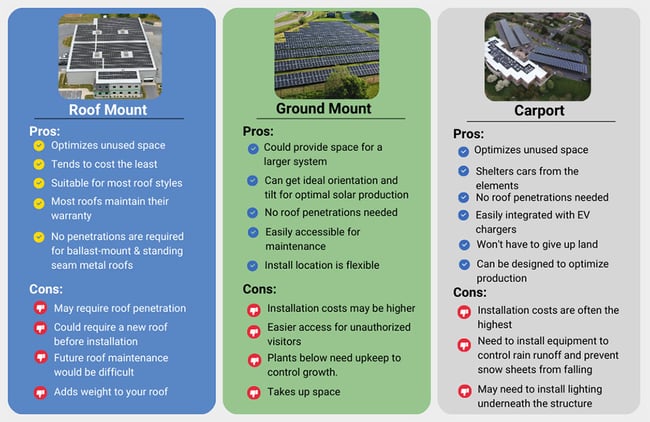
What is Net Metering and Aggregate Metering?
Net metering is, more or less, free energy storage via the utility grid. It’s a billing mechanism that’s invaluable for your system’s payback.
When your solar panels are overproducing, that extra electricity is sent to the utility grid. You are given credit for that electricity that can be used to offset electricity pulled from the grid when your panels aren’t producing enough electricity to run your business.
Most states mandate that utility companies provide net metering, but states are trending away from the traditional method. For example, New York offers a value stack program, and many co-ops in Ohio use a net billing system.
You may be eligible for aggregate or virtual net metering if you have multiple electric meters. This lets you offset electricity usage on any meter or building with the power generated from a solar system connected to another meter. However, policies vary by utility and by state.
Commercial Solar Pricing & Payback
How Much Do Commercial Solar Panels Cost?
Solar is not a one-size-fits-all solution. Therefore it’s difficult to provide an exact cost for a commercial solar system without first knowing how much electricity you use, where the panels will be installed, and other important data points. Your system will be custom-designed for your needs, goals, and budget.
These are the site-specific factors that will impact the system’s cost:
- The Installation Type – Roof, Ground or Carport
- The Type of solar panels, inverters, and other equipment
- Your energy consumption
- Your Local Weather
- Utility Connection Cost
- The Distance from the solar to the interconnection point
The following chart provides an approximate estimate by breaking down the projected installation costs according to average monthly electric bill amounts.
| Electric Bill |
System Size |
The Cost |
Tax Savings | Cost After Incentives |
| $600 | 50 kW | $141,700 | $73,910 | $67,790 |
| $1,200 | 100 kW | $238,600 | $124,453 | $114,147 |
| $2,400 | 200 kW | $430,600 | $224,599 | $206,001 |
How Does the Commercial Solar Tax Credit Work?
The commercial solar tax credit is an incredible incentive for businesses to take advantage of a solar investment.
For systems under 1 MW, the federal investment tax credit is 30%. These projects can also qualify for an additional 10% adders if certain conditions are met. These adders are:
- 10% for a system built in an energy community
- 10% for meeting the domestic content requirements
- 10% if installed in a low-income area or tribal land
The credit starts at 6% and can be increased to 70% if certain conditions are met for installs over 1 MW.
How Does Commercial Solar Deprecation Work?
Businesses can take advantage of accelerated depreciation for their solar investment. 60% of the cost basis can be depreciated in year one on your federal taxes. The remaining 40% follows the five-year MACRS schedule.
State depreciation follows the five-year MACRS schedule.
What Other Incentives Are Available For Commercial Solar?
Apart from the tax savings, two main benefits are the USDA REAP grant and Solar Renewable Energy Credits (SRECs). Certain states and utility companies also provide additional incentives for solar investments.
The USDA REAP grant is a fantastic opportunity for eligible rural businesses and farmers. This competitive grant has the potential to cover up to 50% of your installation cost, with a maximum funding amount of $1 million.
Solar Renewable Energy Credits (SRECs) provide an additional opportunity to generate income from your solar system. Each 1,000 kWh of energy produced by your system earns you one credit, which can be sold. The market for SRECs is influenced by supply and demand, resulting in fluctuating credit prices. It’s important to note that SRECs are not available in all states.
Read more: What Solar Panel Incentives Are Available In Your Area?
What is The Average ROI For Commercial Solar Panels?
A significant portion of the return on investment for a commercial solar project is front-loaded, with the tax credit, depreciation, and USDA grant being recieved the first year or two of the system being energized. This immediately provides you with extra capital to invest in other areas of your business.
What does that mean for the ROI and payback period? We have gathered data from over 300 of our commercial installations to offer insights into the average return on investment (ROI) and payback period in 2024.
The average ROI for commercial solar in 2024 is 16.2%.
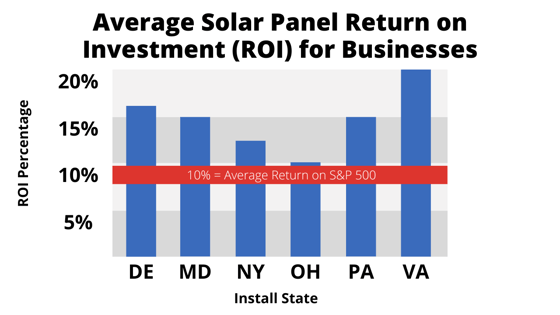
The average payback for commercial solar in 2024 is 9.5 years.
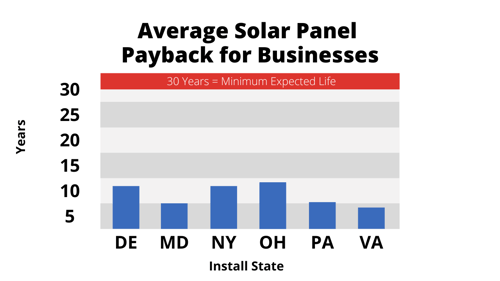
What Financing Options Are Available For Commercial Solar?
There are several financing options available for commercial solar panels. The main options are cash, solar loans, Power Purchase Agreements (PPAs), and solar leases.
Solar loans function similarly to traditional business loans and are typically most easily obtained from your bank.
By entering into a PPA, you authorize another entity to cover the costs of installing and maintaining a solar system on your property. In return, you will enter into a contractual agreement to purchase the electricity generated by the system at a predetermined rate. These agreements typically span from 10 to 25 years and may offer options for extensions.
Solar leases are available as capital leases and operating leases. With a capital lease, the solar system will be listed as an asset on your balance sheet, and you will assume ownership responsibilities. This type of lease also allows you to take advantage of tax incentives. Operating leases are similar to rental agreements. In this arrangement, the solar system will still be listed as an asset on your balance sheet. However, the lessor will retain ownership of the system, receive the tax credit, and be responsible for maintenance duties.
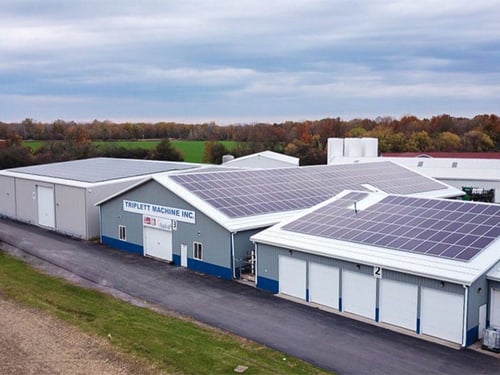
Do Solar Panels Require Maintenance? The Impact on Your ROI.
Unless you receive bad parts, your system was installed incorrectly, or outside factors damage the system, you can expect solar to be a low-maintenance investment that requires minimal upkeep. However, it’s important to note that like any piece of machinery or electronic device, your solar system could occasionally encounter issues that require a professional service provider.
If there is an issue, it will usually be with the solar inverters, which are the most complex component of a solar energy system. Inverters are complex electronic devices that convert the DC electricity into the AC electricity needed to power your business. Some potential challenges that may occur include communication problems between the inverters and the monitoring portal, faults related to wire damage or loose connections, and damage caused by rodents.
The good news is solar panels and inverters come with lengthy warranties. Leading inverter brands have warranties that cover the first 10 – 25 years. Solar panels from leading brands will be guaranteed for around 25 or 30 years.
Furthermore, it is important to partner with a solar installer who offers a comprehensive workmanship warranty and guarantees the production of your solar system. Paradise Energy is proud to offer a Triple Ten Guarantee, providing a ten-year workmanship warranty and ensuring the production of your system for the first ten years. In the unlikely event that there is a difference, we will write you a check for the difference.
Commercial Solar Equipment: Picking The Best Panels and Inverters
You’ve decided to invest in solar energy. Now comes an important step: selecting the best solar panels and inverters. Don’t sweat too much. A reputable installation company will recommend equipment for your system. However, it’s still important to be aware of what’s available.
Is There a Difference Between Residential and Commercial Solar Panels?
Solar panels are generally the same. However, there are a few key differences in size and aesthetics between residential and commercial solar panels.
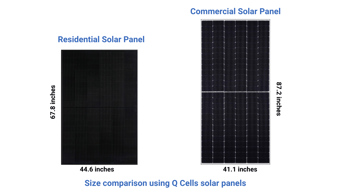 Commercial solar panels tend to be larger than residential panels. Measuring around 45″ x 90″ a commercial panel is designed to produce more energy compared to their residential counterpart that measuring in around 45″ x 70″.
Commercial solar panels tend to be larger than residential panels. Measuring around 45″ x 90″ a commercial panel is designed to produce more energy compared to their residential counterpart that measuring in around 45″ x 70″.
The panel aesthetics also vary greatly. Commercial panels tend to have silver frames that don’t blend with the roof as nicely as the typically residential all-black panels.
Another key difference is that some commercial installations use a bifacial solar panel. This type of panel produces energy from both sides of the panel, from direct sunlight on the top to the sun’s reflection on the backside. These panels are ideal for flat roofs where the panels are tilted up and even some ground mounts.
Read more: Is There A Difference Between Commercial and Residential Solar Panels?
What Are The Best Commercial Solar Panels?
When selecting solar panels, there are several key factors to consider. Those factors are the cost, the panel’s efficiency, the panel’s specs, durability and warranties, and the manufacturer’s reputation & financial stability.
There are many great panel brands to choose from, but several stand out to our product selection team. The three main brands we offer our commercial customers are Axitec, SEG, and Qcells.
Read more: What are the Best Commercial Solar Panels?
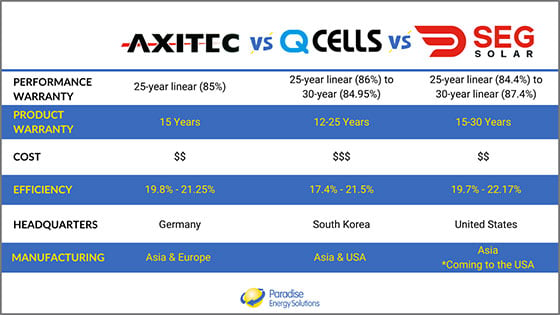
What Are The Best Commercial Solar Inverters?
The solar inverter is a crucial component of a commercial solar panel system. Therefore, it is essential to dedicate time to researching the various types of inverters and the brands available. The choice of inverter can have a significant impact on your return on investment (ROI) as it affects the cost, production, and efficiency of the solar system. Use this breakdown to assist you in selecting the best commercial inverter for your solar panel system.
There are three main types of inverters: string inverters, microinverters, and string inverters with power optimizers. Each type of inverter has its own set of benefits and drawbacks that should be carefully considered in relation to your specific goals and objectives for installing solar energy.
String inverters are the most commonly used inverters for commercial ground mounts. A string converts energy for several solar panels. The downside – if the production drops on just one solar panel in the string, the entire string of panels is impacted.
Whereas with a Microinverter, production drops are limited to the impacted solar panel since they are installed on each panel for module-level optimization. This comes at a much higher cost.
String inverters with power optimizers offer the best of both worlds between string and microinverters. This is the most common inverter combination that we install on commercial rooftops.
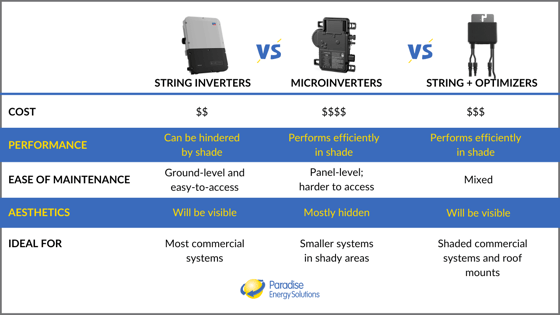
We recommend SolarEdge, SMA, and Chint Power Systems (CPS) to our commercial clients. All three brands have established a reputation for providing top-quality products with lengthy warranties at an affordable cost.
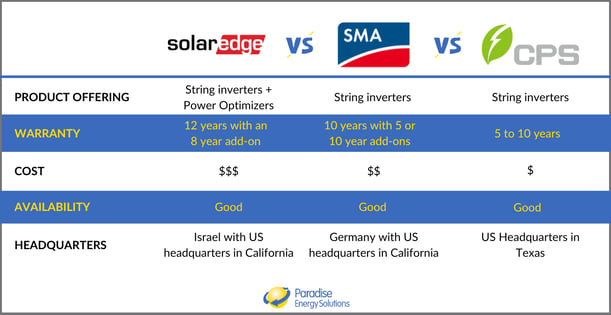
The Installation Process for Commercial Solar
Now that you have a clear picture of the installation cost, incentives, and equipment involved in your solar investment, the next crucial step is to carefully choose your solar installation company. It’s also important to fully comprehend the installation process and how it will impact your day-to-day business operations.
How To Choose A Good Solar Installer?
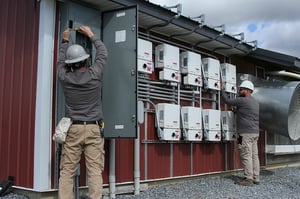 Solar energy is a long-term investment, so it’s essential to choose a solar installer who will be your reliable partner for the long run. Carefully select a local company with in-house expertise that can handle your project from design to installation and provide prompt maintenance support when needed. Additionally, it’s important to choose an installer that stands behind their work with added warranties and guarantees beyond the standard ones offered by equipment manufacturers.
Solar energy is a long-term investment, so it’s essential to choose a solar installer who will be your reliable partner for the long run. Carefully select a local company with in-house expertise that can handle your project from design to installation and provide prompt maintenance support when needed. Additionally, it’s important to choose an installer that stands behind their work with added warranties and guarantees beyond the standard ones offered by equipment manufacturers.
Here are six tips for finding the perfect solar company:
1. Look at their online review and speak to their customers – You will learn a ton about a company by engaging with their past customers. Ask for references. Look at their online reviews on Google and SolarReviews.com
2. Look at their experience and longevity – ensure they have a strong history of doing business the right way. Look for industry training certifications from organizations like NABCEP and Solar Energy International. Also, ask about their financial standing to ensure they are managing the business to be around for the long haul.
3. Examine their warranties – Make sure they offer warranties beyond the standard manufacturer warranties.
4. Interact with their team – Ask about the team that will be involved with your project. See if their website highlights these folks and ask them to meet key team members.
5. Review their mission statement and company values – By reviewing their mission and values, you’ll get a quick look at the DNA of the company.
6. Find consultants, not salespeople – There is a lot to a solar investment, and it’s not for everyone. Find a company that will consult you on the process. Oftentimes, you can quickly root out consultants vs salespeople by examining their websites. Make sure they offer honest, insightful blogs, videos, and other resources.
Read more: Is Paradise Energy The Right Solar Company For You?
How To Evaluate Your Solar Proposals?
Each solar company approaches its proposals differently. However, several key items should appear consistently in all the proposals you receive.
These are the nine essential items that you should review and comprehend to ensure a fair, apples-to-apples comparison of your solar proposal.
1. The size and placement of the system – The overall system size is determined by your energy usage and the number of panels needed to meet your energy needs. Typically, your solar proposal will indicate the size of the system in kilowatts or kW.
2. The system components – The proposal should include a detailed list of components, including the quantity and brand of the solar panels and inverters.
3. The full cost and available incentives – Your proposal should include a detailed breakdown of costs, incentives, potential tax savings, and state or local grants.
4. A full financial analysis – The proposal should include a cash flow analysis with ROI and payback.
5. The energy offset – This information should show you how much energy your system will produce and how much of your usage will be offset by that production.
6. The warranties and guarantees – Solar proposals typically include two types of warranties: manufacturer warranties and warranties from the solar installation company.
7. The project scope – The solar project scope should be clearly defined in the proposal, including what is included, what is not included, and any provisions for unforeseen costs or additions.
8. The installation schedule – The timeline for installing a solar system varies depending on the size of the project. On average, it takes 8 to 10 weeks to design and permit the project, and then a couple of weeks to several months for larger commercial installations.
9. The payment terms – Payment terms should be clearly stated in the proposal to avoid any surprises for both the client and the solar company.
What Is The Process For Installing A Commercial Solar Panel System?
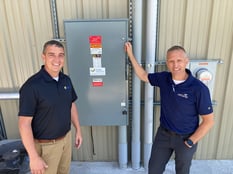 No business owner or facility manager needs another complex task added to their day-to-day schedule. Thankfully, installing a solar system is relatively hands-off and can be completed in six simple steps.
No business owner or facility manager needs another complex task added to their day-to-day schedule. Thankfully, installing a solar system is relatively hands-off and can be completed in six simple steps.
These are the six steps to the solar installation process:
1. Custom Evaluation: You’ll meet with a solar consultant to discuss your questions and energy goals. A solar consultant will examine your recent electric bills and assess your property to determine the optimal size and location for the solar system.
2. Quote Delivery: After 2-3 days, you’ll receive a quote detailing costs, ROI, & payback.
3. Contract Signing: If you decide to move forward, you’ll sign a contract & discuss the nuts & bolts, preparing for construction.
4. Paperwork and Permitting: We’ll finalize the details & take care of all the paperwork, permits, & materials.
5. Construction Begins: The project will proceed with little to no disruptions to your business, & we’ll keep you updated on everything. Construction can take a few weeks to several months depending on the system size.
6. Free Electricity: Once your project is completed you’ll Save With Every Sunrise!





